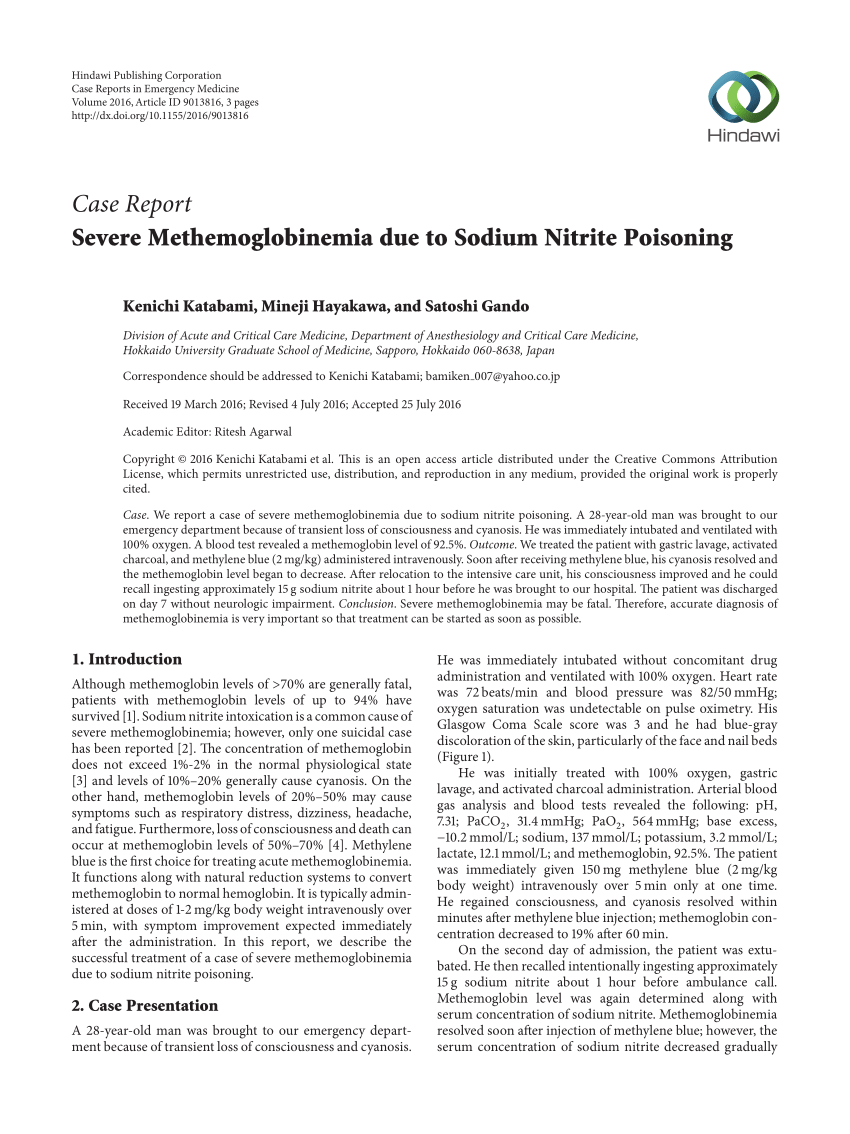H
[HNO]
Experienced
- Aug 21, 2022
- 283
i'm notifying beforehand that this thread is written from layman's perspective so I dont not pretend on any accuracy whatsoever . There's controversy over whether SN overdose has debilitating health complications, in this thread i'll focus only on brain damage.
The first case:
"A 28 year old woman was brought into the emergency department cyanosed and in cardiac arrest. She was found collapsed in a park with a note detailing that she had ingested an unknown quantity of sodium nitrite at up to six hours prior for the purposes of ending her life. A venous blood gas revealed a methaemoglobin percentage of 81%. Following treatment with methylene blue, sodium bicarbonate and adrenaline, the methaemoglobin decreased. Prior to transfer to intensive care, a CT head revealed extensive hypoxic brain injury. Two days later brain death was confirmed on brainstem testing."
The second case:
"A 28-year-old man was brought to our emergency department because of transient loss of consciousness and cyanosis. A blood test revealed a methemoglobin level of 92.5%. Soon after receiving methylene blue, his cyanosis resolved and the methemoglobin level began to decrease. After relocation to the intensive care unit, his consciousness improved and he could recall ingesting approximately 15 g sodium nitrite about 1 hour before he was brought to our hospital. The patient was discharged on day 7 without neurologic impairment."
Brain damage on resuscitation is more likely to take place on the peak of poisoning ie at 90% of blood MtHb (methemoglobin) that's concentration where lethal outcome usually happens and the outcome in some reports patterned as follows: blood of a hospitalized person reaches 90%> concentration of MtHb and following this occurs a cardiac arrest, the EMS staff acting according to cardiac arrest protocol and could save a patient in time, because cardiac arrest in itself is a condition where brain's deprived from the oxygen it often concludes in brain damage of various degrees, which depends on the time of oxygen deprivation.
In order to make comprehension of the material easier i'm including some theory:
"Methemoglobinemia – a condition in which a higher-than-normal amount of methemoglobin is found in the blood. Methemoglobin is a form of hemoglobin that cannot carry oxygen. In methemoglobinemia, tissues cannot get enough oxygen. Symptoms may include headache, dizziness, fatigue, shortness of breath, nausea, vomiting, rapid heartbeat, loss of muscle coordination, and blue-colored skin."
It seems that one hour of gradual increasing of MtHb up to the lethal concentration (90%) can be relatively 'safe' and could end up out w/o any neurological consequences. Now to support my argument, even several minutes of brain hypoxia is enough to cause severe brain damage as in drowning, hanging, inert gas hypoxia etc, but surprisingly 1 hour of hypoxia caused by SN conclude in (relatively) intact brain tissues.
In the first case a person undergone a cardiac arrest and was experienced high MtHb concentrations for long time. The question remains what caused the brain damage, hypoxia or cardiac arrest, because brain damage could have occurred before the cardiac arrest.
The first case:
https://www.researchgate.net/public...a_Due_To_Intentional_Sodium_Nitrite_Poisoning
The second case:

 www.researchgate.net
www.researchgate.net
Also interesting to mention quote from second article (Page 2, Discussion, 2nd paragraph): "Nitrite is also a potent vasodilator and can
cause coronary ischemia and stroke as a result of hypotension, tachycardia, and hypoxia."
The first case:
"A 28 year old woman was brought into the emergency department cyanosed and in cardiac arrest. She was found collapsed in a park with a note detailing that she had ingested an unknown quantity of sodium nitrite at up to six hours prior for the purposes of ending her life. A venous blood gas revealed a methaemoglobin percentage of 81%. Following treatment with methylene blue, sodium bicarbonate and adrenaline, the methaemoglobin decreased. Prior to transfer to intensive care, a CT head revealed extensive hypoxic brain injury. Two days later brain death was confirmed on brainstem testing."
The second case:
"A 28-year-old man was brought to our emergency department because of transient loss of consciousness and cyanosis. A blood test revealed a methemoglobin level of 92.5%. Soon after receiving methylene blue, his cyanosis resolved and the methemoglobin level began to decrease. After relocation to the intensive care unit, his consciousness improved and he could recall ingesting approximately 15 g sodium nitrite about 1 hour before he was brought to our hospital. The patient was discharged on day 7 without neurologic impairment."
Brain damage on resuscitation is more likely to take place on the peak of poisoning ie at 90% of blood MtHb (methemoglobin) that's concentration where lethal outcome usually happens and the outcome in some reports patterned as follows: blood of a hospitalized person reaches 90%> concentration of MtHb and following this occurs a cardiac arrest, the EMS staff acting according to cardiac arrest protocol and could save a patient in time, because cardiac arrest in itself is a condition where brain's deprived from the oxygen it often concludes in brain damage of various degrees, which depends on the time of oxygen deprivation.
In order to make comprehension of the material easier i'm including some theory:
"Methemoglobinemia – a condition in which a higher-than-normal amount of methemoglobin is found in the blood. Methemoglobin is a form of hemoglobin that cannot carry oxygen. In methemoglobinemia, tissues cannot get enough oxygen. Symptoms may include headache, dizziness, fatigue, shortness of breath, nausea, vomiting, rapid heartbeat, loss of muscle coordination, and blue-colored skin."
It seems that one hour of gradual increasing of MtHb up to the lethal concentration (90%) can be relatively 'safe' and could end up out w/o any neurological consequences. Now to support my argument, even several minutes of brain hypoxia is enough to cause severe brain damage as in drowning, hanging, inert gas hypoxia etc, but surprisingly 1 hour of hypoxia caused by SN conclude in (relatively) intact brain tissues.
In the first case a person undergone a cardiac arrest and was experienced high MtHb concentrations for long time. The question remains what caused the brain damage, hypoxia or cardiac arrest, because brain damage could have occurred before the cardiac arrest.
The first case:
https://www.researchgate.net/public...a_Due_To_Intentional_Sodium_Nitrite_Poisoning
The second case:

(PDF) Severe Methemoglobinemia due to Sodium Nitrite Poisoning
PDF | Case . We report a case of severe methemoglobinemia due to sodium nitrite poisoning. A 28-year-old man was brought to our emergency department... | Find, read and cite all the research you need on ResearchGate
Also interesting to mention quote from second article (Page 2, Discussion, 2nd paragraph): "Nitrite is also a potent vasodilator and can
cause coronary ischemia and stroke as a result of hypotension, tachycardia, and hypoxia."

